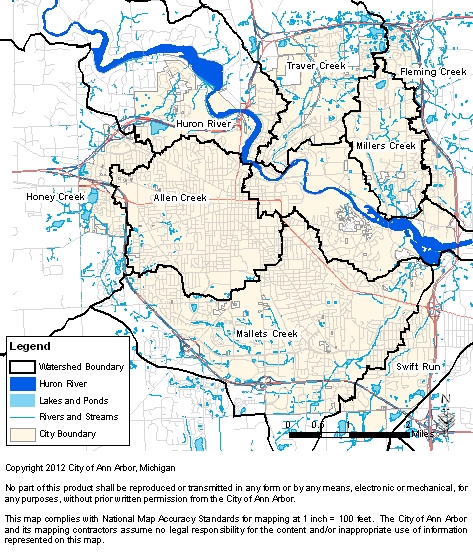Rivers, creeks and trees
The Huron River is Ann Arbor's most important natural feature. It provides 85% of the city's drinking water, along with valued recreational opportunities and quality of life benefits for residents and visitors alike.
The water resources team works to achieve the city's water quality goals related to source water (surface and ground), drinking water, wastewater, and stormwater.
The City of Ann Arbor maintains:
- Over 540 miles of stormwater conveyance system
- Over 23,000 inlets and catch basins
- Over 43,000 street trees
- Over 6,000 park trees

Our Watershed
The Huron River flows through seven counties including: Oakland, Livingston, Jackson, Washtenaw, Wayne and Monroe. It makes its way from its headwaters at Big Lake, near Pontiac, to its mouth at Lake Erie. The Huron River Watershed Council (HRWC) has divided the main course into five geographically defined sections. The Upper Huron, the Chain of Lakes Region, the Upper Middle Huron, the Lower Middle Huron and the Belleville Lake Dam.
The city is a part of the Lower Middle Huron, and works closely with the
Middle Huron Partners group. The group developed the
Middle Huron River Watershed Management Plan, Section 2 to plan activities to address water quality issues throughout the region. The report was originally completed in 1994 and has been updated throughout the years. The most recent version was published in September 2020.
The Middle Huron is further broken into subwatersheds including:
- Allen Drain
- Fleming Creek
- Malletts Creek
- Millers Creek
- Swift Run
- Traver Creek
To identify a location within a subwatershed, and to locate the nearest catch basins visit the City of Ann Arbor Catch Basin Dashboard.
For more information about water quality conditions of Ann Arbor's rivers and creeks visit:
The urban forest
The urban and community forest provides many environmental, economic and social benefits to the community, including reducing stormwater runoff, improving water and air quality, moderating summer temperatures, lowering utility costs, improving quality of life and beautifying the city.
The urban canopy does not stop at the trees lining our streets and within city owned parks, it is also comprised of trees on private property. In recognition of the benefits of maintaining an urban forest, the Office of Sustainability and Innovation has implemented the
10,000 Trees Initiative. The initiative aims to see 10,000 new trees planted on private property by 2030 and offers programs to assist property owners in planting new trees on their property.
